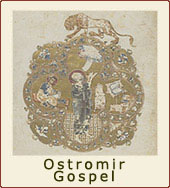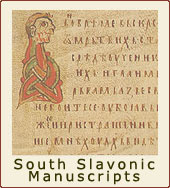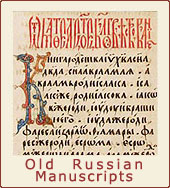
 |
 |
 |
 |
Ostromir Gospel and the Manuscript Tradition of the New Testament Texts
The exhibition "The Ostromir Gospel and the Manuscript Tradition of the New Testament Texts" was held in celebration of the 950th anniversary of the oldest Russian dated book. The exhibition catalogue was prepared as a popular scientific publication, intended for the most general public. The project was launched with assistance from the Russian Humanitarian Scientific Foundation (no. 07-01-93219 а/к).The highlight is the Ostromir Gospel - a truly mysterious memorial of the world culture. Created at the intersection of historical epochs and cultural traditions, this manuscript combines high achievements of book arts of Byzantium and the South Slavs with the mighty cultural potential of Russia prior to the Mongol Invasion. At that, the extraordinary memorial did not become an example for direct copying in the following mediaeval Russian manuscript tradition. It has still kept many secrets, giving rise to diverse scientific hypotheses about its history, its place of origin, the personalities of the scribe and nameless artists, the source of many-sided images used in the illumination of the manuscript.
The peculiar place, that the Ostromir Gospel occupies in the historical and cultural process, allowed to form the conception of the exhibition as display of the previous and following manuscript tradition. The project aims to demonstrate masterpieces of book arts of Byzantium and the South Slavs and to trace the thousand-year way of the development of a Russian manuscript book. Thanks to the fact that sacred texts were copied by only professional scribes, and, usually, these manuscripts were finely decorated, on view in the exibition are unparalleled, the most beautiful examples of mediaeval book arts. They illustrate harmonious synthesis of the text and images, the exquisite calligraphy and endless inventiveness of the refined design, the lofty Christian idea and perfection of the Word of God, recorded on superb leaves of invaluable manuscripts.
64 masterpieces of medieval art are presented together to the view. The exhibition is organised into four sections. Each section is preceded with a brief introduction. The first section is devoted to the Ostromir Gospel. This section contains the brief description of the manuscript (no. 1). The second section demonstrates manuscript book arts from the 6th-13th centuries with the example of 11 Greek manuscripts (no. 2-12). The third section displays 15 South Slavonic manuscript Gospels from the 11th - 16th centuries (no. 13-28), among them is one in Glagolic (no. 13). The most extensive fourth section shows 21 old Russian manuscript Gospels of the 12th - 17th centuries (no. 29-49), and also 3 codeces dating from the 19th century, created for the quite special purpose (no. 50-52). The fourth section has two additional parts. The one of them displays 7 manuscripts of vocal music from the 12th - 17th centuries (no. 53-59), because each reading from the Gospel is followed by sung verses during worship; the other showcases 5 richly adorned bindings of Altar Gospels (no. 60-64), since such decorated bindings are an essential part of the sacred area of the temple.
C. Krushelnitskaya,
Head of
the Old Russian Manuscripts Section of
the Manuscrips Department of
the National Library of Russia